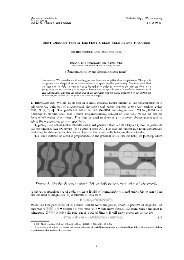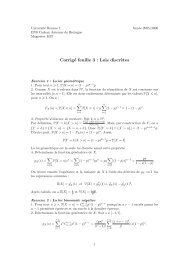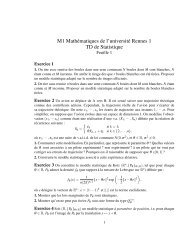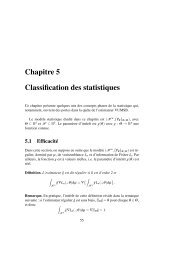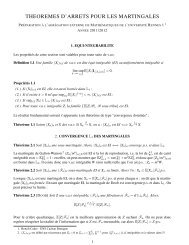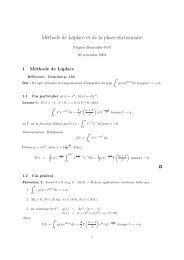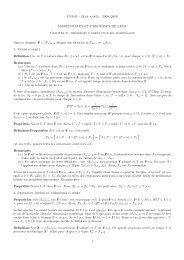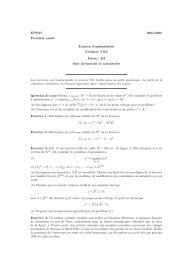Bath Institute For Complex Systems - ENS de Cachan - Antenne de ...
Bath Institute For Complex Systems - ENS de Cachan - Antenne de ...
Bath Institute For Complex Systems - ENS de Cachan - Antenne de ...
You also want an ePaper? Increase the reach of your titles
YUMPU automatically turns print PDFs into web optimized ePapers that Google loves.
Proof. Since supp(u 0 ) ⊂ D 0 , we have that u 0 ∈ H0 1 (D) and it is the weak solution of the newequation −div(a∇u 0 ) = F on D, whereF := fχ 0 + a∇u · ∇χ 0 + div(au∇χ 0 ) on D.To apply Lemma 3.2 we will now extend all terms to R d , but continue to <strong>de</strong>note them the same.The terms u 0 and fχ 0 + a∇u · ∇χ 0 can both be exten<strong>de</strong>d by 0. Their extensions will belongto H 1 (R d ) and H s−1 (R d ), respectively. It follows from Lemma A.2 that au ∈ H s (D) and so ifwe continue au∇χ 0 by 0 on R d , the extension belongs to H s (R d ), since supp(χ 0 ) is compact inD. Using the fact that div is linear and continuous from H s (R d ) to H s−1 (R d ) (cf. [18, Remark6.3.14(b)] and the proof of (A.4) above), we can <strong>de</strong>duce that the divergence of the extension ofau∇χ 0 is in H s−1 (R d ), leading to an extension of F on R d , which belongs to H s−1 (R d ).Let ψ ∈ C ∞ (R d , [0, 1]) such that ψ = 0 on D 0 and ψ = 1 on ˜D c , where ˜D is an open set suchthat D 0 ⊂ ˜D and ˜D ⊂ D. We use the following extension of a from D 0 to all of R d :{ a(x)(1 − ψ(x)) + amin ψ(x), if x ∈ D,a(x) :=a min ψ(x), otherwise.This implies that a ∈ C t (R d ), and for any x ∈ R d , a min ≤ a(x) ≤ a(x) and |a| C t (R d ) ‖a‖ C t (D) .Using these extensions, we have that −div(a∇u 0 ) = F in D ′ (R d ). In<strong>de</strong>ed, for any v ∈ D(R d ),∫∫a(x)∇u 0 (x)∇v(x) = a(x)∇u 0 (x)∇v(x) for any v ∈ D(R d ),R d Dsince supp(u 0 ) is inclu<strong>de</strong>d in the open boun<strong>de</strong>d set D 0 , which implies that ∇u 0 = 0 on D c 0 and a = aon D 0 . Since u ∈ H 1 0 (D), we have by Poincaré’s inequality that ‖u‖ L 2 (D) |u| H 1 (D). Therefore itfollows from Lemma 2.1 that|u 0 | H 1 (R d ) ≤ |u| H 1 (D)‖χ 0 ‖ ∞ + ‖u‖ L 2 (D)‖∇χ 0 ‖ ∞ ‖f‖ H s−1 (D)a min.Since χ 0 ∈ C ∞ (R d ), using Lemma A.2 and the linearity and continuity of div from H s (R d ) toH 1−s (R d ) we further get‖F ‖ H s−1 (R d ) ≤ ‖fχ 0 ‖ H s−1 (R d ) + ‖a∇u · ∇χ 0 ‖ H s−1 (R d ) + ‖div(au∇χ 0 )‖ H s−1 (R d )‖f‖ H s−1 (D) + a max |u| H 1 (D) + |a| C t (D)‖u‖ L 2 (D) + a max ‖u‖ H s (D)‖a‖ C t (D)‖f‖a H s−1 (D).minWe can now apply Lemma 3.2 with A = aI d and w = u 0 to show that u 0 ∈ H 1+s (R d ) and‖u 0 ‖ H 1+s (R d ) 1 ()|a|a C t (D) |u 0| H 1 (R d ) + ‖F ‖ H s−1 (R d ) + ‖u 0 ‖ H 1 (R d ) ‖a‖ C t (D)min a 2 ‖f‖ H s−1 (D) .minThe hid<strong>de</strong>n constant <strong>de</strong>pends on the choices of χ 0 and ψ and on the constant in Poincaré’s inequality,which <strong>de</strong>pends on the shape and size of D, but not on a.Let us now treat the case of u i , 1 ≤ i ≤ m.Lemma A.5. <strong>For</strong> 1 ≤ i ≤ m, u i ∈ H 1+s (D) and‖u i ‖ H 1+s (D) a max‖a‖ C t (D)a 3 ‖f‖ H s−1 (D).min26





